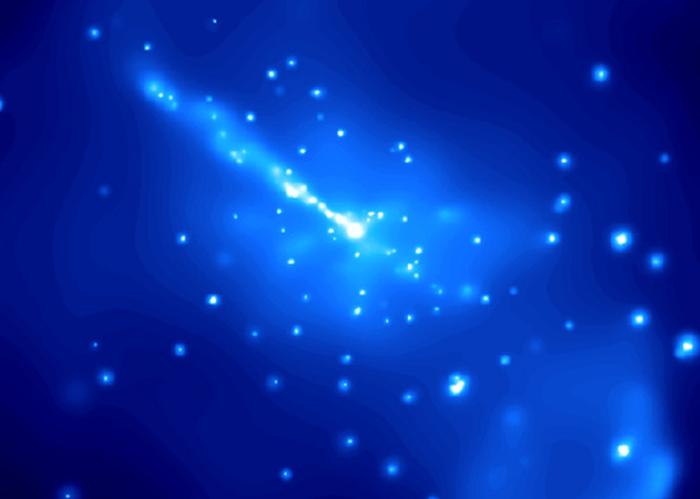Lighthouses of the Universe |
|
During August 6-10, 2001 Garching hosted a large astrophysical conference ``Lighthouses of the Universe'', organized jointly by the Max-Planck-Institute for Astrophysics, Max-Planck-Institut für extraterrestrische Physik, European Southern Observatory and Universitäts-Sternwarte München.

|
| Figure 1: During the conference |
The name ``Lighthouses'', which is unusual for astrophysics, was borrowed from sailors' language to stress that the objects to be discussed are the brightest ones in our Universe, visible even from the most distant parts of it. They are supermassive black holes and supermassive stars, sources of gamma-ray bursts and jets of extremely hot and energetic matter.
Two major groups of questions, related to these extreme objects have been addressed. The first group of questions is: When and how were these objects formed, what source of energy powers them and how do these objects die? The second group of questions is on how one can use these objects to learn more about our Universe, in particular at the early stages of its evolution.
The broad theoretical views on the nature of ``lighthouses'' presented during the conference has been complemented by new astonishing results from orbital and ground based observatories such as Chandra, XMM, VLT and many others. With such powerful instruments one can directly see the objects as they were born many billions of years ago, when our Universe was much younger than now. The discussions of all these exiting topics have been very intense and emotional, not surprisingly given that the subjects are at the verge of modern astrophysics.
One of the projects which is now rapidly evolving into a powerful cosmological tool is the study of distant explosions of supernovae of type Ia, which are potential ``standard candles'' and can be used as a good distance indicator. With the most recent observations one can verify if the expansion of our Universe accelerates or decelerates and other important cosmological parameters. Present data favor an acceleration of our Universe and an important contribution of the so-called Lambda-term, introduced by Einstein in his equations in attempt to build a steady-state Universe, but discarded again after the expansion velocities of the galaxies were discovered by Hubble.
Impressive results of the Sloan (optical) Digital Sky Survey have been reported. Upon completion the survey will map in detail one-quarter of the entire sky, determining the positions and absolute brightnesses of more than 100 million celestial objects. In the early data of the survey, distant quasars with a redshift of more than 6 have been discovered. At that time the Universe was 7 times smaller than now and it was an epoch when the very first ``lighthouses'' were formed.
The distribution of these ``lighthouses'' on the sky is not prefectly uniform. In fact, these lighthouses are tracing the large-scale structure of our Universe. The objects are formed in the regions where gravitational instability developped on the background of tiny initial perturbations, which attracted large amounts of surrounding matter. The present status of the state-of-the-art simulations of the large-scale structure was reported and comparison of the preditions of the simulations and observational has been presented.

|
| Figure 2: Centaurus A: A Nearby Elliptical Galaxy With An Active Galactic Nucleus. (picture taken from the Chandra Photo Album ) |
New results from Chandra and XMM X-ray observatories demostrated the complexity and beauty of another class of lighthouses - clusters of galaxies, where hot gas sitting in the gravitational potential of the cluster is responsible for observed X-ray emission. Shocks, cold fronts, bubbles and other complicated features are now clearly seen in these objects. The same observatories are now pushing forward the study of the X-ray background which is composed primarily of the contributions of distant Active Galactic Nuclei and quasars and one needs full power of modern observatories to find and discover these. With Chandra and XMM more than 90% of the X-ray background has already been identified with individual sources.
Very interesting numerical and analytical results have been reported on the formation of the very first and very massive stars. These stars are thought to be responsible for injecting the first heavy elements into the primordial gas which consisted mostly of hydrogen and helium.
An extremely interesting session was the one devoted to the formation of supermassive black holes and the extraction of energy form these objects. These monstrous objects (with masses of billions of the mass of our Sun) are the most luminous sources in the distant Universe. The same objects are present in our vicinity (within 10-20 Mpc), but for some reason they are dormant and emit at a much lower level than their analogs at larger distances. What powers these objects: accretion of matter or rotation of the supermassive black holes? And why are they so dim in our vicinity? These were very important and nagging questions.
A special session was devoted to the Gamma-Ray Bursts. During the past few years the detection of afterglows in the X-ray, optical and radio energy bands, following the short outburst of gamma-ray emission, and the identification of the host galaxies proved that the sources of the bursts are at cosmological distances. Various models of these objects were presented and discussed. The possibility to use the GRBs for studies of the environment in distant galaxies was stressed.
Many other topics were considered at the conference, including gravitational lenses, the physics of jets, the nature of the most powerful objects in various energy bands etc. The conference was certainly a success and we all learned a lot about new and exiting facts and ideas.
Rashid Sunyaev, Marat Gilfanov, Eugene Churazov
Further information:
| MPA-Home |